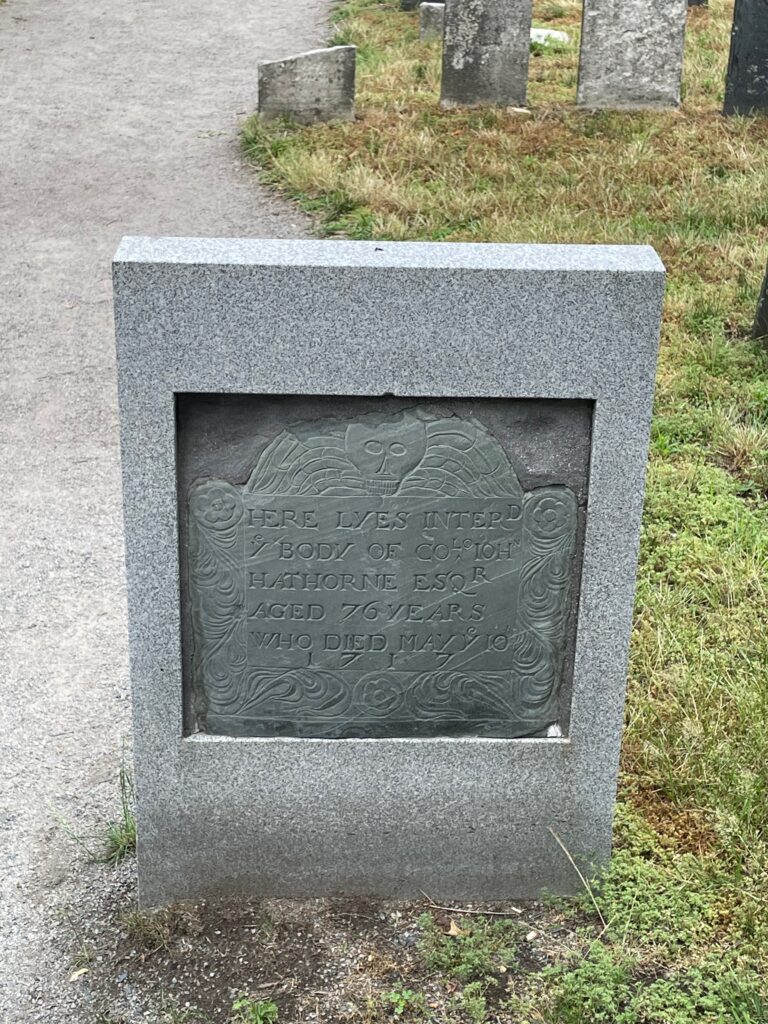Erik Visits an American Grave, Part 1,850
This is the grave of John Hathorne.

Born in 1641 in Salem, Massachusetts, Hathorne grew up in what passed for the elite of early Massachusetts. Early Puritan Massachusetts was theoretically anti-elite and there was a lot of mistrust of people who were overly interested in gathering wealth. Still, social divisions did occur and Hathorne’s father began to accumulate land and merchant interests. By the time Hathorne grew up and took these over, some of the suspicion had fallen away, at least a little bit. He started buying up more land in what is now Maine and he also expanded his father’s initial shipping interests into the West Indies, which of course meant slavery. Over the years, Hathorne rose in Puritan society into greater positions of authority and respect. He was not a political leader per se, but he was definitely someone who needed to be listened to. He was on the colony’s council of assistants and a lot of that work was about mediating disputes between towns, which was common at that time.
Hathorne would not be remembered today if it wasn’t for his role in the Salem witch trials. He was all in. He was one of the first people called in to question potential witches and he believed they were basically all guilty. Here is a transcript of one of his interviews of Bridget Bishop:
Bishop : I am no witch
Hathorne : Why if you have not wrote in the book, yet tell me how far you have gone?
Bishop : I have no familiarity with the devil.
Hathorne : How is it then, that your appearance doth hurt these?
Bishop : I am innocent.
Hathorne : Why you seem to act witchcraft before us by the motion of your body which seems to have influence upon the afflicted.
Bishop : I know nothing of it. I am innocent to a witch. I know not what a witch is.
Hathorne : How do you know then that you are not a witch?
Bishop : I do not know what you say.
Hathorne : How can you know, you are no witch, and yet not know what a witch is?
Bishop : I am clear…
This is the kind of questioning that gets one a job in the Trump administration.
Hathorne demanded an all out witch hunt throughout New England. He totally believed in the conspiracy of witches, all the way to the end of his life.
Now, Hathorne did not get appointed to the tribunal that would decide the fate of these poor innocent people. So if you want to argue that he’s not the worst human involved in the Salem trials, I guess you have evidence for others. But let’s be clear–he wanted them all dead. Unlike Samuel Sewall, who later repented for his sins in Salem and gave people of the future something to learn from him, Hathorne was a true believer all the way. This isn’t uncommon. We’ve seen this over and over again, from slavery to Watergate to the crimes of the Bush and Trump years. A few people will repent for their sins or see some kind of light. Liz Cheney I guess is a good example of this, but she’s still a horrible human being, just one with a line that could not be crossed. OK, good for her, I guess. But most of them will defend their actions to the grave. Hathorne was that type of guy. Also, Hathorne was a big enough deal in the witch trials that he is a character in Arthur Miller’s The Crucible.
Later in life, Hathorne became more involved in military issues in New England. That’s especially true during King William’s War, one of the more forgotten of the many wars between the English and French at this time. He was one of the Puritan leaders in the Siege of Fort Nashwaak in 1696. I freely admit I had never even heard of this before. Fort Nashwaak is today Fredricton, New Brunswick. He was promoted to colonel in the militia in 1711. He also spent the first decade of the eighteenth century on the colony’s Superior Court, a position he desperately wanted.
Hathone was the great great grandfather of Nathaniel Hawthorne. It was the author himself who changed the spelling. Hawthorne was deeply ashamed of his ancestor and it’s been suggested that it was to distance himself from his murderous ancestor is why, though that seems a bit extreme to me. I mean, we all have terrible humans in our families. Of course, writing a hack campaign biography for Franklin Pierce does not exactly cover one in glory for the future either. Hathorne was also a character in Stephen Vincent’s Benet’s “The Devil and Daniel Webster.” He was the judge.
Hathorne died in 1717. He was 75 years old.
John Hathorne is buried in Burying Point Cemetery, Salem, Massachusetts.
If you would like this series to visit other people who enjoyed tormenting people who dissented from society in some way, you can donate to cover the required expenses here. Joseph McCarthy is in Appleton, Wisconsin and Martin Dies is in Lufkin, Texas. Previous posts in this series are archived here and here.


